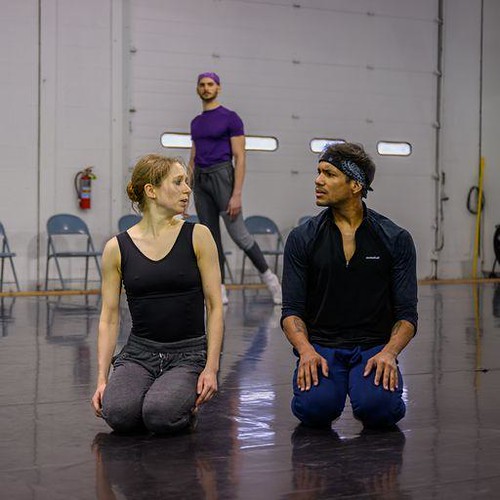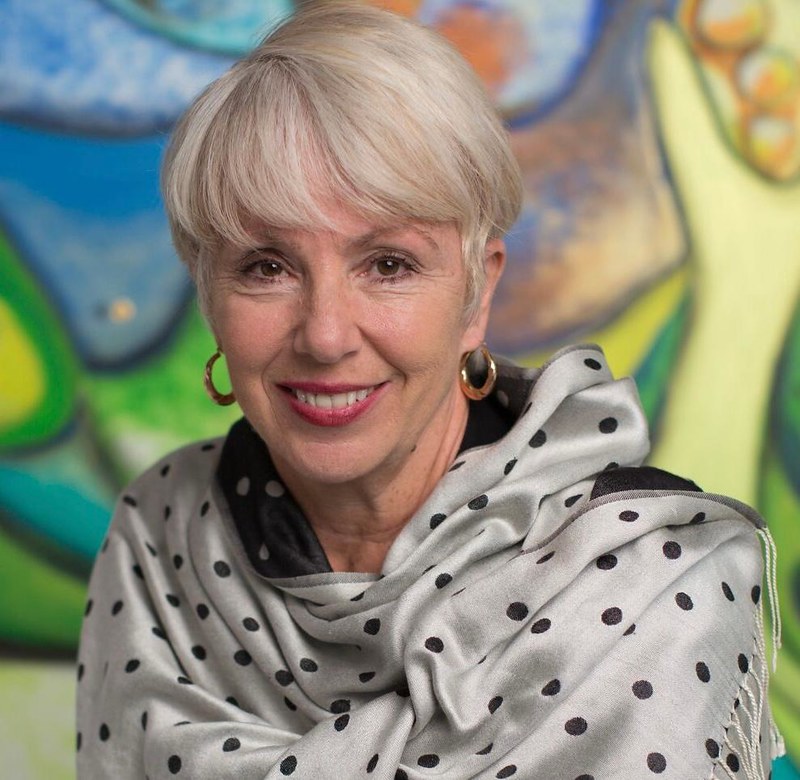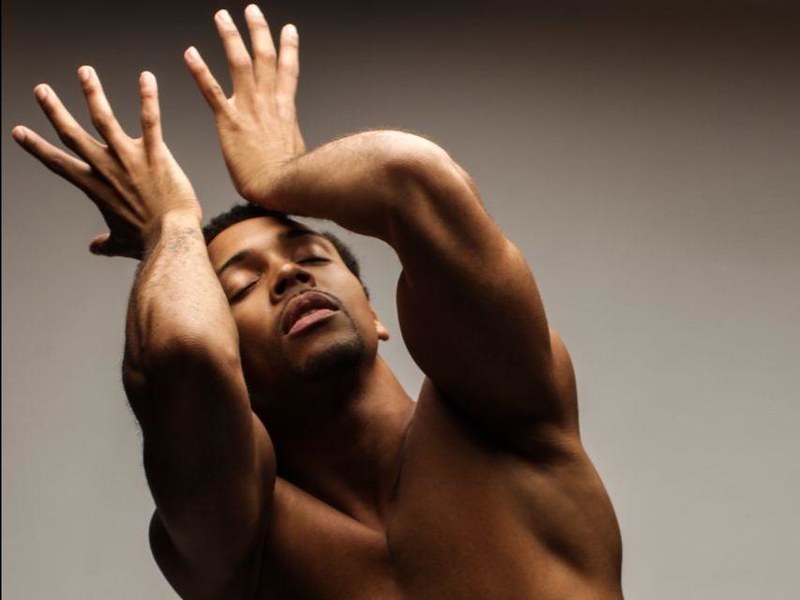
Sat 2/18 @ 7:30PM
Our Christmas decorations were just coming down when it was time to start working on a preview of Verb Ballets’ February concert. What’s new? What do the choreographers and rehearsal directors have to say for themselves? What does the dancing look like in rehearsal? We lay it all out for you here.
The upcoming concert will consist of Gerald Arpino’s Celebration, a Verb premiere; a new ballet choreographed on the Verb dancers by Levi Marsman, a world premiere; and a piece from the Verb repertoire, Richard Dickinson’s Four Last Songs.
We watched Cameron Basden, the répétiteur, or rehearsal director, from the Arpino Foundation, begin to teach Celebration to the Verb dancers. First she teaches the five couples a phrase that they practice in unison from stage left to stage right. Then she directs them to perform the same phrase circling the stage. There’s a one-handed lift that two of the couples practice. Arm positions are sometimes those of Russian character dance, with one hand on the back of the head and the other hand on hip. We’ve been told that Verb Ballets is the first dance group other than the Joffrey Ballet to perform Celebration.
Later in the week we exchanged a few emails with Ms. Basden. First we asked her to explain to our readers who Gerald Arpino is.
Cameron Basden: Gerald Arpino was co-founder of the Joffrey Ballet with Robert Joffrey in 1956. Joffrey became the Artistic Director and Arpino, initially a dancer in the company, after an injury started thinking of choreography. He soon became resident choreographer of the company. While Joffrey’s vision encompassed historical works and innovative new choreographers and choreography, it was Arpino’s choreography that gave the company a cohesive look and was a consistent presence as Joffrey realized his vision. While it was mainly the Joffrey alone that did Arpino’s choreography, his importance to American dance is profound. Now we are very excited to be bringing his choreography to the wider dance community.
ClevelandConcertDance: What distinguished Arpino’s choreography?
CB: Gerald loved the meticulousness and sensuality of classical ballet yet was enamored with the groundedness and use of space, the swirling torso and back that modern dance encompassed. And he merged those two together in his choreography. Dance critic Walter Terry said, “He introduced a synthesis of torso-oriented modern movement with classical ballet that was a special quality he gave to ballet.”
CCD: I want to ask you to compare and contrast the Joffrey Ballet and the other American ballet companies but first I must admit my bias. I’ve been an enthusiastic audience for Arpino and the Joffrey Ballet since I first saw them at Delacorte Theatre in New York’s Central Park in September of 1965. (It was my sophomore year at Oberlin College. Why wasn’t I studying?) And it was Arpino’s mix of ballet and modern dance that caught my eye. But that said, how does the Joffrey compare with other American ballet companies?
CB: As a dancer in the New York Joffrey, I felt that American Ballet Theater was the classical company — everyone knew them and their international roster of stars. NYCB was Balanchine and Robbins. Joffrey was everything in between — new, undiscovered works and choreographers, historical reconstructions, present day icons (Ashton, Cranko, Kylian), and in the New York dance scene, there was a place for it all. Twyla Tharp broke into the mainstream when she did Deuce Coupe with the Joffrey. Mark Morris did his first “ballet” on the Joffrey; Laura Dean did her first pointe ballet on the Joffrey. Lots of “firsts.”
CCD: Amen. Let me add that the Joffrey did all this with a fraction of the money that NYCB had. In December of 1963 the Ford Foundation announced a major grant of $7.7 million “to strengthen classical ballet in the United States.” Balanchine, his ballet company New York City Ballet, his School of American Ballet, and his offshoot companies like Pennsylvania Ballet, got the lion’s share. As if that wasn’t enough of a windfall, in April of 1964, NYCB moved into what was then known as the New York State Theater, newly built for $19 million dollars and only part of what eventually became a $185 million campus. Meanwhile, Joffrey Ballet got 10 years of residency at City Center, a much older and smaller theater, and a $155,000 grant. (Modern dance got nothing). Ford Foundation, the Rockefellers, Robert Moses and the U.S. government had chosen NYCB as the virtual national ballet, a benefit that Balanchine and company mostly did not abuse.
CCD: How do dance companies become licensed to perform an Arpino dance?
CB: The Arpino ballets are licensed through Charthel Arthur, the executive director of the Arpino Foundation. The licenses are very amenable to the needs of each particular organization — and especially in this two-year centennial celebration year, the fees are low. While most répétiteurs are familiar with the organizations that we license works to, it is always favorable to discover new organizations such as Verb. We want to know that the organization (university, school, company) is capable of mastering Arpino’s choreography appropriately and we enjoy introducing new dancers and organizations to the movement, style and energy that Arpino ballets require. Sometimes a connection is made through our répétiteurs and sometimes we have organizations or individuals reach out to us and we then connect them to the ED. Then we have to do our research. So while companies might apply we have to ensure it’s a good fit.

CCD: We understand that the original lighting for Celebration at its premiere in 1980 was by Thomas Skelton, who our readers might remember for his long association with Heinz Poll’s Ohio Ballet. What can you tell us about lighting for Celebration? What input or support does Arpino Foundation provide to licensees?
CB: The lighting technology has changed tremendously since many of the Arpino ballets were first created. So, having worked with Arpino and understanding his “vision” for the ballets, we work with each organization’s lighting designer to recreate the lighting according to the abilities of the organization and as true to what the original look was. We also pay attention to the abilities of lighting of today. Arpino had a very distinct palette that he preferred for his ballets — using templates and dappled lighting. If I remember correctly, he was the first choreographer that used templated lighting on the stage.
CCD: Original costumes for Celebration were by Santo Loquasto. What costumes will Verb be using?
CB: We use the original costumes if available or recreate them based on the original concept. They are not exact copies but good facsimiles to manifest Arpino’s vision. Since we’ve been staging the ballets and new costumes have been built, we have a pretty good rental system as to where to go to rent what, if needed. Verb has built lovely costumes, a little different but based on the original Santo Loquasto designs.
CCD: We notice that Celebration was one of two scores by Dmitri Shostakovich that Arpino choreographed to. What is the name of the Shostakovich composition used in Celebration? The whole piece or excerpts?
CB: Celebration was choreographed to the Shostakovich score Concertino for Two Pianos, Opus 94, and was rearranged/adapted by Elliot Kaplan. Many Arpino ballets were musically arranged to accommodate the ballet.
CCD: We always say that Shostakovich wrote some of the best music for dance that the 20th century has to offer but that during his lifetime the Soviets hounded him mercilessly for the sin of “formalism.” Now that Stalin is dead and the Soviet Union has fallen, choreographers are discovering Shostakovich. Alexei Ratmansky has choreographed nearly a dozen works to Shostakovich. Locally, present and former Verb dancers Kelly Korfhage and Christina Lindhout set their FEAST to selections of Shostakovich chamber works. With sharp contrasts and a wonderful variety of emotions, Concertino for Two Pianos, Opus 94 provides a fine introduction to the composer.
CCD: What’s your personal connection with Arpino and Celebration?
CB: As a young, inexperienced and hungry dancer, I was fortunate to spend much time with Arpino in the rehearsal studio. We had a really great choreographer/dancer relationship. In the studio working with him, I learned very much about his quality of movement, his speed, how he used space, and so much else. Celebration was the first ballet we worked on together with Glenn White, who was a fantastic partner. In 1979, I had just joined the company when the company had an unexpected layoff of five months. It was unfortunate for the company but a huge benefit for me. It was during this time that Arpino and I spent many hours in the studio working. And much of this time was focused on his new ballet, Celebration. It was a magical time for me.
CCD: Final thoughts?
CB: Celebration has a demi-character feel [Demi-character dance makes stylized reference to traditional folk or national dance while remaining within classical technique], though it is totally classical, with Arpino’s signature speed and movement. He made the demi-character style his own with flexed feet, swirling patterns and “flavors.” Celebration is a very difficult ballet; it has lots of fast footwork, challenging rhythms and unity in the performers while each individual is given an opportunity to shine. It is a celebration of dance, of movement, of joy, and especially, in this centennial year, is a celebration of Arpino’s work and the exuberance that Verb Ballets brings when they dance this piece.
Verb Ballets is the first dance organization to perform Celebration outside of the Joffrey Ballet and I couldn’t be more pleased with their work, their talent, and their maturity. I know this will be a fantastic performance.

Levi Marsman is a freelance dancer, emerging choreographer and dance teacher. Currently based in Boston where he grew up, he’s formerly of Ailey II.
We arranged to watch one of his rehearsals and arrived at the Verb studios just as Marsman was playing a recording of Brandi Carlisle and Sam Smith singing “Party of One.” No, Marsman was not choreographing to the piano ballad. Instead he was setting the mood. More about “Party of One” later.
Then Marsman answered questions from the dancers. Antonio Morillo asked how he should approach his role as the angel of death; another dancer’s question about death and grief prompted Marsman to acknowledge that his own aunt’s recent death had influenced this dance but that he wanted to include other more mundane interpretations of the dance’s meanings, explaining that sometimes death interrupts important interpersonal communications and sometimes we just need to catch a plane. Kate Webb reflected, “We’re all dealing with finitude. None of us knows how long we have.”
The rehearsal began with a duet — or is it a trio? Lieneke Matte and Bryan Andres Salinas pull apart but come back together. Something is wrong between them. Morillo looms in the background, either the angel of death or a clock ticking away the moments.
We asked Marsman about his intentions in a phone interview.
Levi Marsman: I thought I was going to Cleveland with nothing, a clean slate, but shortly before I left Boston, my husband and I got into a rather heated argument [laughs] and I felt like things were being left unsaid. So when I got to Cleveland, I started building a combination with the dancers based on the idea of getting everything out in time.
I’m usually an abstract choreographer but that idea turned into the duet that the piece starts with. You have something to say and maybe you’ve already said it a million times but you decide to slow down and say it one more time.
That first section, the duet, is titled “Take Time” and it shows two dancers, a couple, trying to get things across to each other. The third character that you see upstage is not necessarily the angel of death, but just kind of a reminder that you only have a certain amount of time to get some things said.
The second section, titled “Time’s Up,” makes it clear that all of that urgency was because there’s not enough time to get everything said.
CCD: What’s the overall title of your dance?
LM: When the Saints Go Marching In.
CCD: What’s the music that the dance is set to?
LM: It’s by David Lang. “Take Time” is set to “Memory Pieces.” “Time’s Up” is set to “Increase.”
CCD: And what’s the relevance of the song, “Party of One”?
LM: The song says, “I’m leaving now but I’m coming home tonight. If we fight in the morning, let’s not fight at night.”
CCD: The bottom line?
LM: I’m very happy with how this piece turned out. Verb Ballets has a really diverse group of dancers and they’re really open, vulnerable and collaborative, which makes the process a joy to experience.
CCD: For us, this is an emotional, dramatic dance that absolutely delivers on its premise. It provides a fine vehicle for the Verb dancers. See it if you possibly can.

CCD: Hi Richard. Thanks for talking with me. What exactly is the title of your dance?
Richard Dickinson: It’s called Four Last Songs.
CCD: Set, of course, to the Four Last Songs of Richard Strauss. Back in the day I listened to these a lot. I was scrolling through YouTube earlier and pow! There was the Elisabeth Schwarzkopf/George Szell recording that I had on vinyl. There are a lot of layers here with the songs, the lyrics and your dance.
RD: I’m using the recording by Kiri Te Kanawa. She’s beautiful. The lyrics to the four songs are poems by Joseph Eichendorff and Hermann Hesse. Back when I was a teenager, Siddhartha by Hermann Hesse was one of my favorite books. Anyway, about that time somebody told me about Four Last Songs and I fell in love with them without knowing what they meant at all.
The first song is Spring so I took it as meaning birth, giving birth, a new time. The translation is something like: “I have long dreamt of your trees and blue skies, of your scents and the songs of birds.”
CCD: Just to interject, spring is something we’re all looking forward to this time of year.
RD: Or it’s like meeting someone brand new. Spring is renewal. I’m thinking of changing the costumes to suggest nudity, but that might not come about. Then the second song is September, about autumn, but I’m taking it to mean middle age. “Summer smiles, amazed and exhausted… slowly its great weary eyes close.” Then the next song is On Going to Sleep. The ladies are lying very flat and the men walk around them, so, yearning for slumber. The last song is Sunset and that’s the one I know most about. Basically, it’s about an aging couple. They’re at the end of their lives, looking at the setting sun and they ask, “Is this perhaps death?” The poem mentions “Two larks still soar alone” and Strauss’ music makes some little bird sounds. My dance ends as the female character walks away into heaven.
CCD: So, last performed in 2013? Sorry to say, I can’t remember seeing it.
RD: Yes. I’ve re-choreographed some parts to better suit our current dancers.
CCD: We wanted to ask you how you choose music. Is there a philosophy or a method?
RD: When I listen to music, I see if it needs dance to complete it. Some music is complete. Most Wagner, most Beethoven, I would never tackle. But some music, I close my eyes and I see images.
CCD: How many dancers?
RD: Four male and four female.
CCD: Looking forward to seeing it.
Verb Ballets presents Celebrations Saturday February 18 @ 7:30pm at the Breen Center for the Performing Arts in Ohio City.For tickets go to verbballets.org/celebrations23 or call 216-397-3757.
[Written by Elsa Johnson and Victor Lucas]